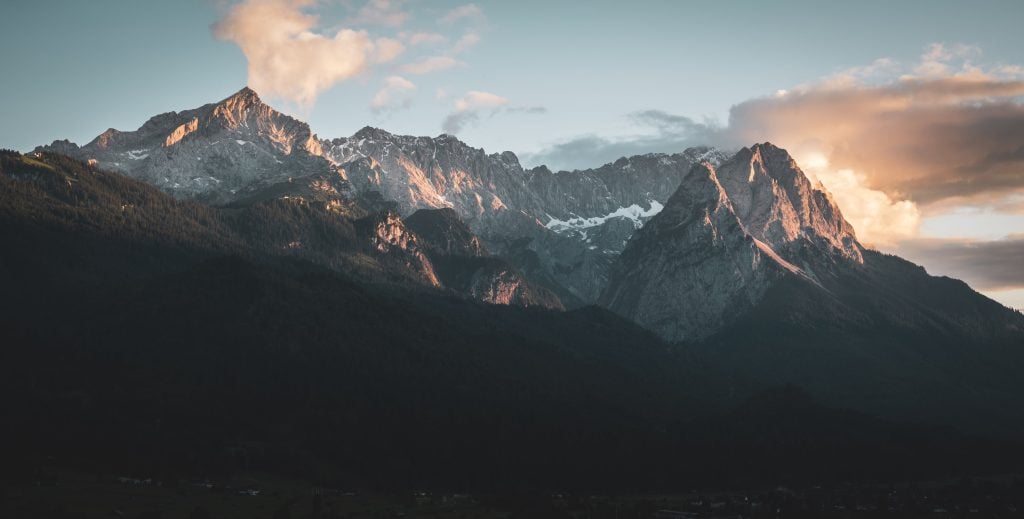Highest Mountains in Germany
Germany hosts a diverse range of natural beauties, and among them, mountains play a significant role. The country’s mountain ranges vary from the Alps to the Harz Mountains. The highest peak, Zugspitze, symbolizes Germany’s roof, while other summits like Watzmann and Brocken are renowned for their unique landscapes and natural allure. These mountains offer a wide array of activities throughout the seasons, from winter sports to hiking, providing visitors with a diverse range of experiences. Combined with Germany’s historical and cultural heritage, its mountains present a unique opportunity for those seeking to explore the country’s natural wonders.
Zugspitze: Majestic Heights and Alpine Adventures in Germany’s Pinnacle
Zugspitze, Germany’s highest peak, stands as a majestic icon in the Bavarian Alps. Soaring to an elevation of 2,962 meters, it is a prominent destination for both nature enthusiasts and adventure seekers. Positioned on the border between Bavaria and Tyrol, Zugspitze offers breathtaking panoramic views and a plethora of outdoor activities. Accessible via various cable cars and train lines, reaching the summit is an adventure in itself. Whether it’s winter sports like skiing or summer pursuits like hiking, Zugspitze captivates visitors with its natural beauty and diverse recreational opportunities, making it a must-visit gem in Germany’s alpine landscape.
Exploring the Majesty of Germany’s Hochwanner Mountain
Hochwanner is a summit located in the Wetterstein Mountains in the Bavarian Alps, Germany. Standing at an elevation of 2,746 meters, this mountain holds a significant position in the Zugspitze Range. Hochwanner is renowned for its impressive mountain views, rich flora, and fauna. Popular among alpine climbers, the peak offers a spectacular experience for nature enthusiasts. It is also part of the natural parks and protected areas in the region, providing tourists with a unique Alpine atmosphere. Hochwanner is an ideal destination for both its natural beauty and opportunities for mountain-related activities.
Watzmann Mountains: Germany’s Alpine Gem in Bavaria
Watzmann is a significant mountain located in the Berchtesgaden Alps in the Bavarian region of Germany. Rising to an elevation of 2,713 meters, it stands as the second-highest peak in Germany. Comprising three main summits, Watzmann is known for its natural beauty, rich biodiversity, and mountaineering potential. A popular destination for nature enthusiasts, the mountain is also renowned among alpine climbers. Designated as a natural conservation area, Watzmann and its surroundings feature stunning lakes and valleys, offering tourists an unforgettable mountain experience. This impressive mountain stands out as one of Germany’s natural treasures, providing breathtaking views from various perspectives.
Mount Hochkalter: Germany’s Peak in the Bavarian Alps
Hochkalter is an impressive mountain located in the Bavarian region of Germany, rising in the Berchtesgaden Alps. With a peak reaching up to 2,607 meters, it stands out for its captivating natural beauty. Hochkalter is renowned for its steep peaks and granite rock formations, making it a popular destination among nature enthusiasts and mountaineers alike. The mountain attracts alpine climbers with challenging rock climbing routes that offer both difficulty and rewarding experiences.
Mount Hochvogel: An Alpine Peak in Germany
Hochvogel is an impressive mountain situated in the Allgäu Alps, straddling the border between Austria and Germany. With its peak reaching an elevation of 2,592 meters, Hochvogel stands as a prominent natural attraction in the region. The mountain is renowned for its steep slopes and imposing rock formations, making it a popular destination among both climbers and nature enthusiasts.
What mountains are in Germany?
| Peak | Height (m) | Mountain range4 |
| Zugspitze | 2,962 | Wetterstein |
| Hochwanner | 2,744 | Wetterstein |
| Watzmann Middle Peak | 2,713 | Berchtesgaden Alps |
| Leutascher Dreitorspitze | 2,682 | Wetterstein |
| Hochkalter | 2,607 | Berchtesgaden Alps |
| Biberkopf | 2,599 | Allgäu Alps |
| Großer Hundstod | 2,593 | Berchtesgaden Alps |
| Hochvogel | 2,592 | Allgäu Alps |
| Östliche Karwendelspitze | 2,538 | Karwendel |
| Hocheisspitze | 2,523 | Berchtesgaden Alps |
| Hoher Göll | 2,522 | Berchtesgaden Alps |
| Hochkarspitze | 2,482 | Karwendel |
| Großes Teufelshorn | 2,361 | Berchtesgaden Alps |
| Kahlersberg | 2,35 | Berchtesgaden Alps |
| Stadelhorn | 2,286 | Berchtesgaden Alps |
| Großer Daumen | 2,28 | Allgäu Alps |
| Höfats | 2,257 | Allgäu Alps |
| Soiernspitze | 2,257 | Karwendel |
| Hoher Ifen | 2,229 | Allgäu Alps |
| Große Arnspitze | 2,196 | Wetterstein |
| Kreuzspitze | 2,185 | Ammergau Alps |
List of highest mountains of Germany
What is the highest mountain in Germany?
The Zugspitze is the highest mountain in Germany, with an elevation of 2,962 meters (9,721 feet). It is located in the Bavarian Alps, along the border with Austria.
What are other notable mountains in Germany?
- Berchtesgaden Alps: Watzmann (2,713 m), Königssee lake
- Black Forest: Feldberg (1,493 m), Titisee lake
- Harz Mountains: Brocken (1,142 m), Hexentanzplatz
- Taunus Mountains: Großer Feldberg (881 m)
- Eifel Mountains: Eifel Crater
Is mountaineering a popular sport in Germany?
Yes, mountaineering is a popular sport in Germany. There are climbing routes of different difficulty levels all over the country. The most popular climbing areas include the Bavarian Alps, the Berchtesgaden Alps, and the Black Forest.
Can I do winter sports in the mountains of Germany?
Yes, many mountains in Germany are suitable for winter sports. There are many slopes and facilities for skiing, snowboarding, cross-country skiing, and ski touring. The most popular winter sports areas include the Bavarian Alps, the Black Forest, and the Harz Mountains.





